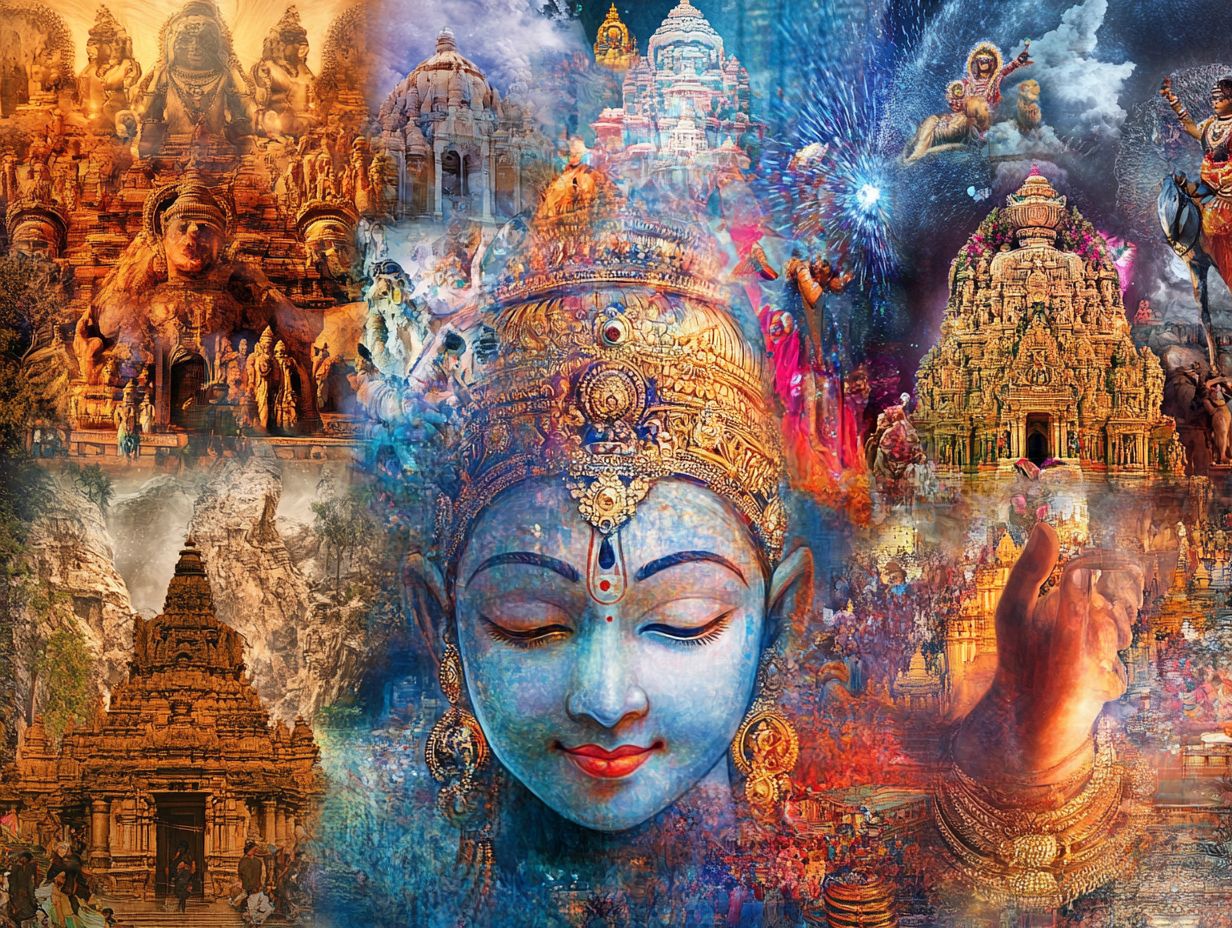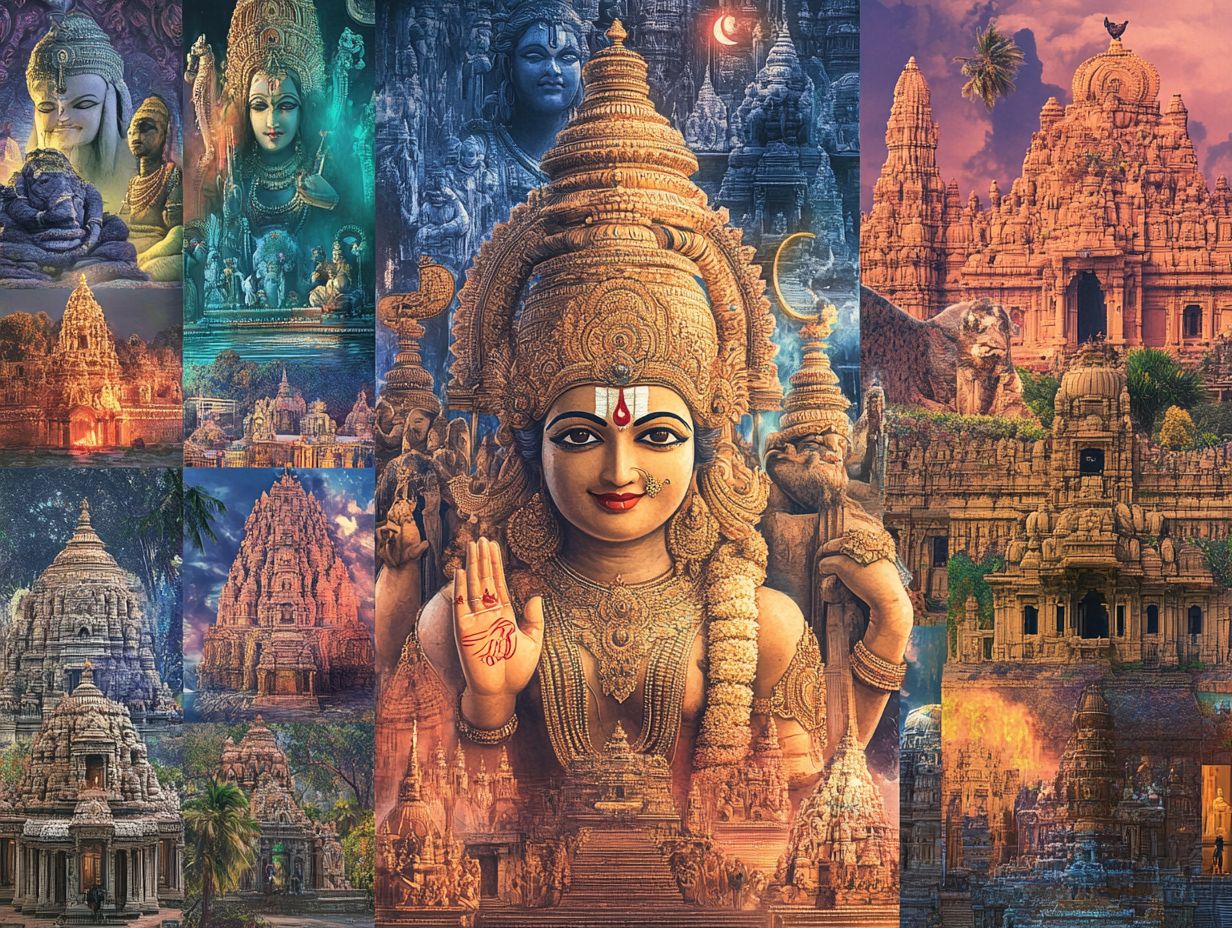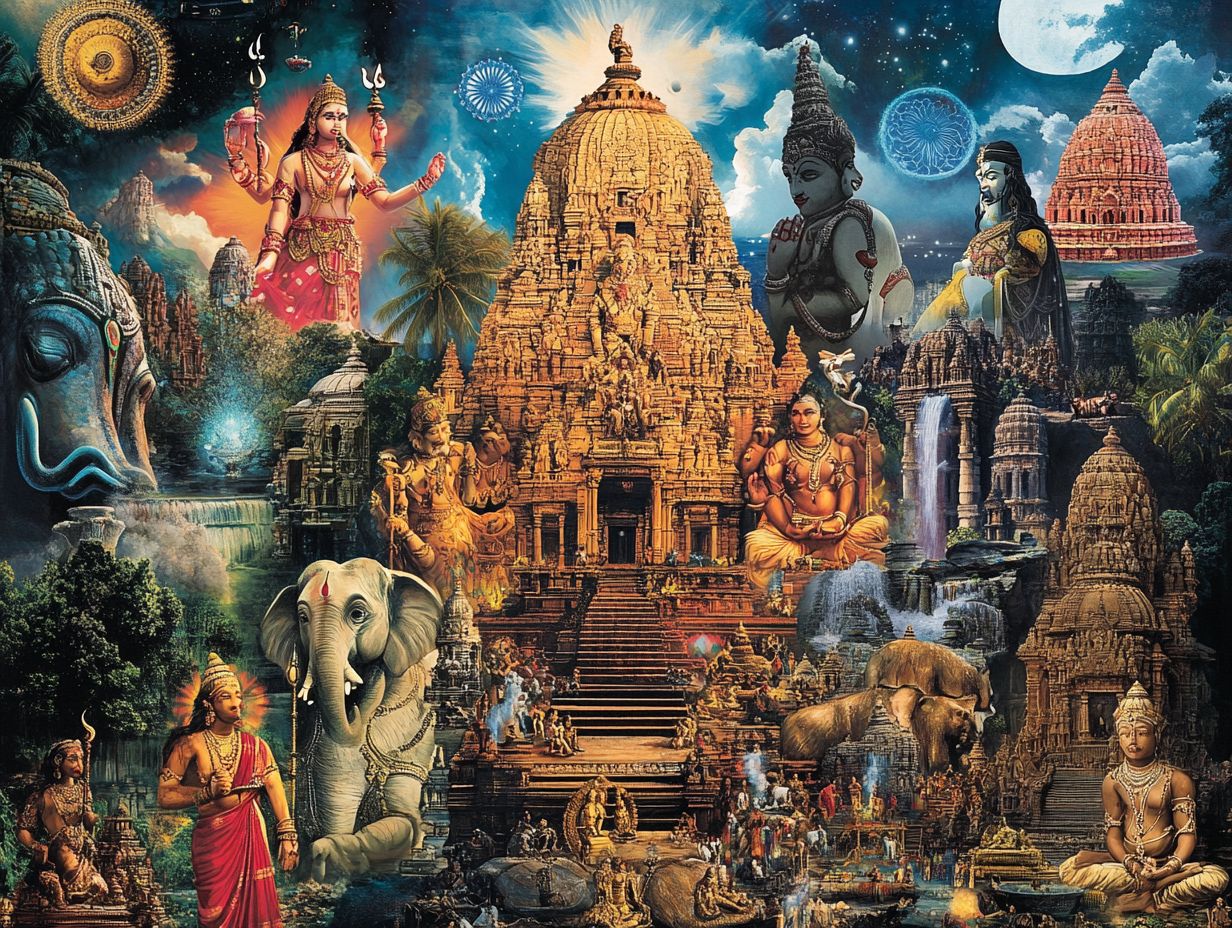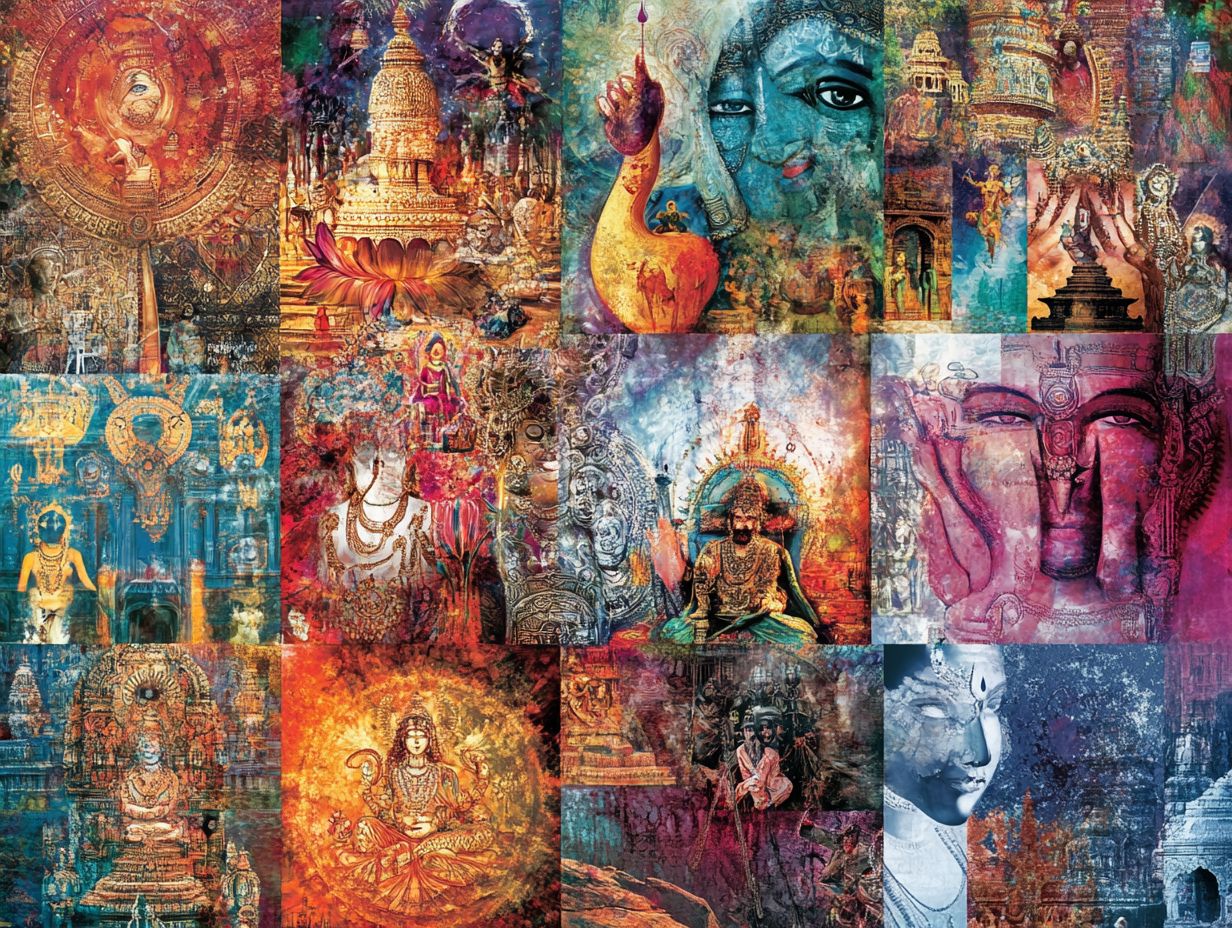How Did Hinduism Become a Complex Religion?
Hinduism, recognized as one of the world’s oldest religions, has experienced a profound evolution over millennia, intricately weaving a rich tapestry of beliefs, practices, and rituals.
This exploration delves into the journey of Hinduism, tracing the development of its revered sacred scriptures, including the Vedas and Upanishads, and the emergence of diverse sects shaped by social and political transformations.
It scrutinizes the complex concepts of Brahman, Atman, karma, dharma, the significance of deities, and the overarching effects of colonialism and modernization on the faith.
In contemporary times, the diversity within Hinduism is striking, manifesting in its regional variations, cultural diversity, and myriad interpretations, making it an intriguing subject for those captivated by religion and culture.
The complexities of Hinduism, including its traditions, rituals, and ethical considerations, and its enduring legacy in the modern world invite thoughtful examination and appreciation.
The Evolution of Hinduism

The evolution of Hinduism unfolds as a captivating narrative, woven from ancient traditions and the emergence of revered scriptures such as the Vedas, Upanishads, and the Bhagavad Gita. This intricate historical journey has been profoundly influenced by diverse cultural factors over millennia.
Hinduism, with its rich complexity, embodies a tapestry of beliefs, philosophies, and practices that have significantly shaped not only the spiritual landscape of India but also its societal norms, ethical principles, and moral values.
1. The Development of Hindu Scriptures
The development of Hindu scriptures represents a pivotal element of Hinduism, with texts such as the Vedas, Upanishads, and the Bhagavad Gita serving as foundational sacred documents that encapsulate the core philosophies, beliefs, and ethical principles of this ancient religion. Each of these texts emerged within distinct historical contexts, offering profound insights into the rituals, spiritual practices, and historical evolution that define the faith.
The Vedas, regarded as the oldest scriptures, establish the groundwork for various rituals and hymns, significantly influencing Hindu worship and societal norms. Following this, the Upanishads delve into philosophical concepts such as Brahman and Atman, encouraging believers to pursue deeper spiritual understanding beyond mere ritualistic observance. The influence of Bhakti and yoga further emphasizes personal devotion and spiritual connection.
Similarly, the Bhagavad Gita distinguishes itself as a vital dialogue that confronts ethical dilemmas and underscores the significance of duty (dharma), shaping the moral framework for countless adherents.
Together, these scriptures reflect an evolving comprehension of existence, guiding practitioners on their spiritual journeys and enriching their connection to the divine.
2. The Emergence of Different Sects
The emergence of various sects within Hinduism underscores its dynamic nature and inherent diversity, where a multitude of beliefs engenders practices that span from monotheism to polytheism, weaving a rich tapestry of regional variations, spiritual expressions, and syncretic practices.
This pluralism is prominently illustrated in major sects such as Vaishnavism, which reveres Vishnu and his avatars, and Shaivism, which centers on the worship of Shiva. Shaktism, on the other hand, celebrates the divine feminine, placing emphasis on the worship of goddesses and highlighting the significance of Shakti, or cosmic energy.
Each sect is characterized by its own distinct scriptures, rituals, and philosophies, which shape the spiritual lives of its adherents while often incorporating local customs.
These distinctions not only contribute to the vibrant religious landscape of India but also embody the overarching principles of unity and diversity that define Hindu thought, inviting individuals from a myriad of backgrounds to discover their unique paths to spirituality through pilgrimage, community gatherings, and personal devotion.
3. The Influence of Social and Political Factors
Social and political factors have profoundly influenced the evolution of Hinduism, shaping its practices, the caste system, and the societal norms that govern community life throughout history. The interplay between religion and social structure is deeply embedded in Hindu traditions and rituals.
These influences can be traced back to ancient times when the religion was closely intertwined with royal patronage and governance, creating a dynamic interplay between spiritual beliefs and political authority.
Historical events including invasions, colonialism, and reform movements have further transformed the landscape of Hinduism, prompting adaptations in rituals and new interpretations of scriptures. Consequently, the evolution of Hindu practices reflects not only divine teachings but also a response to shifting social hierarchies and political dynamics.
This intricate relationship continues to shape contemporary discussions surrounding identity, caste, social justice, and religious tolerance within the community.
The Complexity of Hinduism
The complexity of Hinduism stems from its multifaceted nature, encompassing a vast array of beliefs, philosophies, and practices that reflect a rich spirituality and remarkable diversity. From intricate rituals to varied interpretations of sacred texts, this intricate tapestry not only showcases the profound depth of religious thought but also highlights the vibrant traditions that have evolved over centuries.
It captures a wide spectrum of practices, ethical principles, and cultural influences that collectively define the faith, showcasing the resilience and continuity within the diaspora.
1. The Concept of Brahman and Atman
The concept of Brahman in Hinduism embodies the ultimate reality and the cosmic spirit that forms the basis of all existence, serving as a cornerstone for comprehending the intricate cosmology and philosophies, including the concept of Atman, that facilitate spiritual awakening within this rich tradition.
This multifaceted notion is interpreted in various ways across different sects. For instance, Advaita Vedanta perceives Brahman as a singular, formless essence, while the dualistic perspectives of Dvaita emphasize a distinct separation between the individual soul (Atman) and the divine.
These varying interpretations not only underscore the diversity of thought within Hinduism but also reflect the profound spiritual inquiry that Brahman inspires. Within the broader framework of Hindu cosmology, Brahman encompasses the entirety of the universe, weaving together the material and the spiritual. This interplay encourages practitioners to embark on a journey toward unity with the divine.
Such explorations frequently yield profound insights into the nature of existence, the self, and the interconnectedness of all life.
2. The Role of Deities

The role of deities in Hinduism, characterized by a rich pantheon of gods and goddesses, exemplifies the religion’s polytheistic nature and highlights the significance of worship, devotion, and personal connection to the divine. Personal altars and icons often feature prominently in these practices, serving as focal points for offerings and prayers.
Each deity embodies distinct attributes and responsibilities, representing various facets of life and the cosmos, from the benevolent creator Brahma to the formidable protector Durga. Worship practices exhibit considerable diversity, ranging from elaborate rituals conducted in temples to intimate prayers offered at home altars, enabling practitioners to express their reverence in ways that resonate deeply with them.
Festivals such as Diwali and Navaratri unite communities in celebration, marking the triumph of good over evil while honoring these divine figures through songs, dances, and generous offerings. This richness in worship not only reinforces individual beliefs but also cultivates a collective identity among devotees, reflecting the dynamic and evolving relationship between the divine and the mortal realm. These events often include elements of pilgrimage and community gatherings that strengthen social bonds.
3. The Importance of Rituals and Practices
Rituals and practices hold immense significance in Hinduism, serving as profound expressions of devotion, discipline, and spirituality. The spectrum of these ceremonies ranges from daily worship to grand festivals, with meditation and yoga embodying vital pathways to spiritual enlightenment. Family rituals and samskaras (rites of passage) also play a critical role in fostering a sense of community and continuity.
Such diverse rituals not only bolster individual faith but also weave a deep, communal bond among practitioners. Daily pujas, for instance, are essential in many households, allowing devotees to cultivate a sense of gratitude and connection to the divine each morning. Major festivals like Diwali and Navaratri unite families, fostering a spirit of joy and collective celebration.
The practice of yoga and mindfulness facilitates individuals in aligning their inner selves with a higher belief system, promoting tranquility and self-awareness. Together, these elements create a rich tapestry of reverence that profoundly influences the daily lives of Hindus, guiding them toward a more meaningful existence. Asceticism and tantric practices are other paths that some practitioners follow to achieve spiritual goals.
4. The Caste System
The caste system in Hinduism epitomizes a multifaceted social structure that has profoundly impacted societal norms, ethics, and morality within the religion, often intricately woven into spiritual beliefs and practices. Despite its historical roots, modern challenges and debates continue to shape its relevance and application in contemporary society.
Historically, this stratified framework emerged in ancient India, shaping not only individual identities but also the dynamics of communities. Over the centuries, the caste hierarchy established rigid divisions among diverse groups, determining access to resources, education, and opportunities. This structure has left a lasting imprint on societal interactions, influencing aspects ranging from marriage customs to occupational choices.
In contemporary discourse, scholars and activists are thoroughly scrutinizing the caste system’s relevance, assessing its implications for social justice and equality. Many contend that, despite legal reforms aimed at dismantling caste-based discrimination, its vestiges endure in various forms, underscoring the need for ongoing dialogues to cultivate a more inclusive society. This examination also delves into the intersections of cultural diversity and social structure within Hinduism.
The Impact of Colonialism and Modernization
The influence of colonialism and modernization on Hinduism has precipitated significant transformations within its practices and beliefs. These changes have introduced new dynamics through globalization and cultural exchange, ultimately reshaping the religion in the context of contemporary society. The adaptation of ancient traditions and rituals to modern contexts further reflects this evolution.
1. The Spread of Hinduism to Other Countries
The spread of Hinduism to various countries illustrates its remarkable global influence, particularly through the diaspora, where communities have preserved their religious identities while seamlessly adapting to new cultural contexts. This global presence has facilitated cross-cultural interactions and the integration of indigenous beliefs and practices.
This adaptation often results in fascinating blends of traditional beliefs with local customs, creating unique expressions of faith that resonate with a diverse audience. For example, in the United States, practitioners have woven yoga and meditation into their daily routines, placing a strong emphasis on wellness alongside spiritual growth.
Festivals such as Diwali and Holi are celebrated with great enthusiasm, transcending cultural boundaries and fostering intercultural dialogue. Additionally, the interaction with Western philosophies has prompted a reinterpretation of doctrines, nurturing a dynamic evolution of practices that attract both devoted followers and intrigued onlookers alike, significantly shaping the global spiritual landscape. These celebrations also highlight the syncretism that characterizes Hinduism’s adaptation to different cultural environments.
2. The Influence of Western Ideas
The influence of Western ideas on Hinduism has catalyzed modern adaptations and reinterpretations of traditional beliefs and practices, fostering a dynamic interplay between Hindu spirituality and contemporary thought. This exchange has paved the way for meaningful dialogue, prompting Hindu communities to explore and occasionally embrace concepts such as individualism, secularism, and human rights, which are prevalent in Western philosophies.
Consequently, many practitioners find themselves weaving ancient rites with fresh perspectives, crafting a unique cultural tapestry that addresses both spiritual aspirations and modern societal challenges. This synthesis has not only enriched individual practices but also transformed community dynamics, encouraging interfaith discussions and collaborations that bridge Eastern and Western values. The teachings of gurus and religious leaders play a pivotal role in navigating these changes.
Ultimately, this convergence contributes to a more nuanced global understanding of spirituality.
3. The Challenges of Modernization

Modernization presents distinct challenges for Hinduism, as traditional practices and ethical principles grapple with the pressures exerted by rapidly evolving societal norms and global influences.
The advent of technology and the proliferation of social media have profoundly transformed the methods by which spiritual teachings are communicated and interpreted, often resulting in a disconnection between established beliefs and contemporary values.
As younger generations adopt globalized perspectives, they increasingly question age-old customs, leading to shifts that affect various aspects of community life, from ritual practices to gender roles. This generational shift often prompts the exploration of new philosophical schools and interpretations within Hinduism.
Persistent societal issues such as caste discrimination and gender inequality ignite discussions among practitioners, compelling many to reevaluate their relationship with their faith.
This ongoing dialogue surrounding identity, cultural heritage, and modern ethics highlights the intricate balancing act that Hinduism must perform as it navigates the complexities of the modern world. The resilience of Hindu traditions in the face of modern challenges underscores the religion’s capacity for continuity and change.
The Diversity of Hinduism Today
The contemporary landscape of Hinduism is characterized by a rich tapestry of regional differences, interpretations, and practices that exist in harmonious coexistence. This diversity not only highlights the religion’s remarkable adaptability but also underscores its enduring relevance in today s world.
1. Regional Differences
Regional differences in Hinduism illustrate the profound influence of local cultures on the religion’s practices, beliefs, and rituals, resulting in a vibrant mosaic of expressions across India and beyond.
In regions such as Kerala, for example, the integration of ancient folk traditions with Hindu beliefs is evident in the unique festivals and temple ceremonies celebrated throughout the year. Similarly, in Punjab, the infusion of Punjabi culture transforms Hindu practices, creating a distinctive blend characterized by joyous celebrations and active community involvement. These regional variations highlight the importance of family rituals and the preservation of cultural identity in different parts of India.
Each locality contributes its own unique customs, from culinary variations to sacred dances, further enriching the tapestry of Hinduism. Consequently, devotees discover personal meanings within their regional interpretations, allowing them to connect deeply with their faith while embracing the diverse heritage that shapes their spiritual journey. This diversity in practices and beliefs illustrates the complexity and adaptability of Hinduism.
2. Different Interpretations and Practices
The myriad interpretations and practices within Hinduism exemplify the religion’s inherent flexibility and depth, allowing adherents to engage with a multitude of philosophies that resonate with their individual spiritual journeys.
These diverse interpretations have emerged from centuries of historical evolution, cultural influences, and regional traditions, illustrating how practitioners can adopt distinctive rituals and beliefs that enrich their spiritual experiences. For example, while some may immerse themselves in devotion through bhakti, others might choose to explore jnana, the path of knowledge, or karma, which underscores the significance of actions and their consequences.
This plurality cultivates a sense of community among practitioners, as they discover common ground in their quest for truth whilst celebrating the intricate tapestry of Hindu thought. Such a dynamic not only deepens personal understanding but also fosters connections within the broader societal framework.
3. The Coexistence of Hinduism with Other Religions
The coexistence of Hinduism with other religions serves as a compelling illustration of the principles of religious pluralism and interfaith dialogue, promoting a culture of acceptance and understanding among varied faith systems.
This harmonious interaction not only emphasizes the intrinsic values that form the foundation of Hindu beliefs but also unveils the common threads that interweave various spiritual traditions. Through open discussions and a commitment to mutual respect, practitioners of Hinduism and adherents of other faiths cultivate a fertile environment for collaboration, allowing shared values such as compassion, tolerance, and love to thrive.
Events like interfaith gatherings and dialogues exemplify a dedication to fostering a society where differences are embraced rather than feared. These interactions stand as a crucial reminder that through cooperation and mutual understanding, communities can unite in their pursuit of peace and justice. Such gatherings often explore shared ethical considerations and the significance of symbols in different faiths.
Frequently Asked Questions
How Did Hinduism Become a Complex Religion?

Hinduism is one of the oldest religions in the world, with a long and complex history that has contributed to its development into a multifaceted and diverse belief system. This complexity arises from its vast array of philosophies, rituals, and traditions. Let’s explore some common questions about how Hinduism became such a complex religion.
What is the history of Hinduism?
Hinduism traces its roots back to ancient Indian civilizations, with evidence of its existence dating back to around 500 BCE. It is believed to have evolved from the beliefs and practices of the Indus Valley Civilization and has been influenced by various cultures, invasions, and migrations over the centuries. The religion’s sacred scriptures, including the Vedas and Upanishads, have played a crucial role in shaping its doctrines and practices.
How did Hinduism develop into a complex religion?
Hinduism’s complexity can be attributed to its integration of various cultural, philosophical, and religious ideas and practices. As it spread and evolved over time, Hinduism absorbed and incorporated different beliefs and practices into its already existing traditions, resulting in a diverse and complex religion. The interplay between various philosophical schools, such as Bhakti and Jnana, further contributed to this richness.
What are the main beliefs and practices of Hinduism?
Hinduism is a diverse religion, and its followers hold different beliefs and practices depending on their region, family traditions, and personal interpretations. However, some common beliefs and practices include the belief in multiple deities, reincarnation, karma, and the pursuit of moksha (liberation from the cycle of rebirth). Key concepts such as Brahman (the ultimate reality) and Atman (the soul) are central to Hindu thought.
How did Hinduism influence Indian society and culture?
As one of the oldest religions in India, Hinduism has played a significant role in shaping and influencing Indian society and culture. Its teachings and practices have had a profound impact on art, literature, music, and other aspects of daily life in India, making it an integral part of the country’s identity. The influence is evident in temple architecture, devotional music, and the sacredness attributed to various aspects of life.
Has Hinduism faced any challenges or changes throughout history?
Throughout its long history, Hinduism has demonstrated remarkable resilience and adaptability, navigating various social and cultural challenges. These include the impact of colonialism, the pressures of modernization, and the influences of globalization. The religion’s ability to integrate and transform in response to these factors has been a key to its continuity and relevance.
Like any other religion, Hinduism has faced challenges and undergone changes throughout its history. It has faced invasions, conflicts, and criticisms, but has also adapted and evolved to meet the changing needs and beliefs of its followers. Hinduism’s complexity is evident in its diverse practices, rituals, traditions, and ancient texts such as the Vedas and Upanishads. The religion embraces a variety of philosophies including Bhakti and yoga, and worships numerous deities such as Brahman and Atman. Concepts like karma, dharma, samsara, and moksha are central to its philosophy. The caste system, cultural diversity, and regional variations contribute to its rich tapestry. Hinduism’s historical evolution showcases its resilience and adaptability. It also engages in syncretism, incorporating indigenous beliefs and practices. Pilgrimage, festivals, spirituality, meditation, and family rituals are common practices. The religion’s social structure, ethics, and moral values are influenced by its ancient texts and religious leaders, including gurus. Worship often involves altars, icons, and offerings, reflecting community life and rites of passage such as samskaras. Asceticism, tantric practices, cosmology, mythology, narratives, and oral traditions also play a role. Sacred geography, religious tolerance, interfaith dialogue, and the effects of globalization and modernization are significant. Hinduism’s philosophical schools offer varying interpretations, while its historical context highlights influential figures and cultural impacts. The religion has significantly influenced art, music, dance, architecture, and temple rituals. Symbolic meanings, life cycles, ethical considerations, inclusivity, personal devotion, and meditation practices are intrinsic. Reverence for life, nature worship, traditional values, and modern challenges shape its cultural identity. The Hindu diaspora reflects these beliefs and values globally, engaging in cross-cultural interactions.
